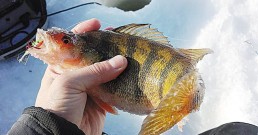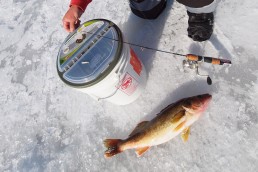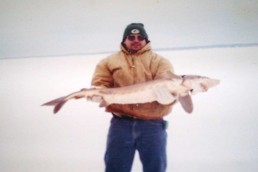Stay Safe, but Ready for Trouble on the Ice
SHARE THIS POST
Ice fishing is supposed to be a good time during the winter months while we wait for the first signs of the thaw to arrive. However, every year ice fishermen and even trappers fall victim to the ice and the dangers of falling through, unaware of what measures to take if the worst-case scenario happens.
Safety should be first and foremost with the fisherman.
There are precautions an outdoorsman can take to prevent falling through weak ice. Unfortunately, no matter how careful we are on the ice, there is always the risk of getting wet in these deadly, sub-freezing waters, especially if one does not know what to do in case of this emergency. This article is intended to help prevent these accidents and what to do should one occur.
One of the biggest reasons people go through the ice is that they get on an area that is not thick enough to support them and their equipment. Four inches of clear ice is the bare minimum for a person to safely walk on. An ATV or snowmobile will take at least 5 inches of ice, and a vehicle will require 8 inches, with 12 being ideal.
There are many factors into whether ice is safe or not—and these are only guidelines. Early and late in the season is often the most dangerous times to be on ice.
Each body of water has its known danger areas. If you are going to be on unfamiliar waters/ice, check with locals who know where “problem ice” can be. They can give you a lot of valuable information.
Are you enjoying this post?
You can be among the first to get the latest info on where to go, what to use and how to use it!
Even though I stated what the thickness of ice should be when driving on it, try not to drive on it, if at all possible. If you must take a drive, keep the windows rolled down and your seat belt off. Remember, a vehicle can be replaced, so do not hesitate leaving it in a hurry if things go awry.
Keep in mind that snow weakens the stability of the ice. Do not test just one area of the ice and assume that it will be the same depth at all areas of the lake, reservoir or pond—it might not be.
Remember, always have someone with you and let people back at the house know where you will be and when you expect to return. That way, if you do not return on time, they’ll know exactly where to go and look for you.
Frostbite and hypothermia are also concerns for ice fishermen. You must be alert to the amount of time you are on the ice and the weather conditions while fishing. Do not get overwhelmed with all the excitement and stay out too long.
Below are more ice fishing safety recommendations:
- Wear a warm hat that covers your ears. In cold weather, 75 to 80 percent of heat loss from the body occurs from an uncovered head.
- Go with a partner and stay separated when going to and from fishing spots in case one of you falls through the ice.
- Carry a rope to throw to someone who has fallen through the ice. Go out to that person only as a last resort.
- Test the ice ahead of you with an ice spud bar or an auger.
- Do not leave children unsupervised.
Have fun on the ice, but obey the laws. Check the regulations to make sure there are no laws governing the particular ice you are fishing.
MWO
SHARE THIS POST
Did you enjoy this post?
You can be among the first to get the latest info on where to go, what to use and how to use it!
Jason Houser
Jason Houser is an avid outdoorsman from Central Illinois. Houser has been a full-time freelance writer since 2008. He is also the host of Jason Houser Outdoors, airing on the Hunt Channel. He can be found on Facebook at Jason Houser Outdoors or on the web at jasonhouseroutdoors.com.



